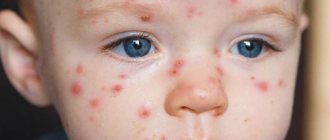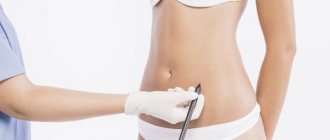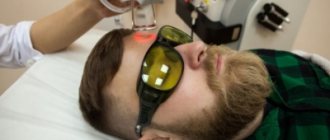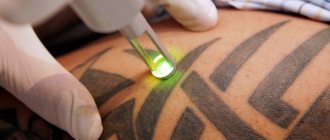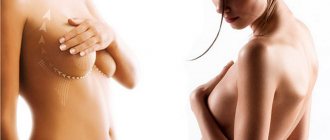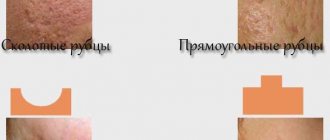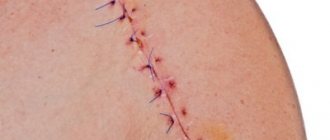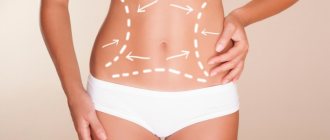Scar
is the result of the biological process of healing wounds of the skin or other tissue resulting from injuries, burns, operations and diseases, without which no living organism can exist.
According to WHO analytical data, about 50 million people are injured annually in the world, more than 100 million undergo surgical interventions, which leave scars. Keloid and hypertrophic scars are observed in 4.5% - 10% of the general population.
Diagnosis of pathological scars does not present great difficulties and is based on anamnestic data and clinical manifestations. However, despite the keen interest of scientists in this problem, it should be recognized that until now the degree of understanding of the processes occurring in tissues leaves much to be desired and often comes down to empiricism.
Correction of scar deformities is one of the most difficult tasks in aesthetic medicine. Scars are not only a source of aesthetic and psychological problems, but also cause a number of unpleasant subjective sensations. Currently, there are a large number of scar treatment methods, but none of them alone can guarantee quality. This problem requires an integrated approach and the involvement of doctors of several specialties - surgeons and dermatocosmetologists.
Types of scars and scars on the face
Before understanding the types of scars, it is worth understanding what they are. The replacement of an injured and damaged skin area with connective tissue is called a scar. Which includes collagen, but the cells are arranged in a different order. In healthy skin, its cells line up sequentially, but in scarred skin they line up chaotically. This is what causes the change in structure, color and elasticity.
Facial scars in men and women are divided into the following types:
- Keloids. They arise as a result of a failure and excessive production of collagen. The scar rises above the surface of the skin, often having a dark color. In medicine, they are considered benign neoplasms and tend to grow on healthy areas of the skin. The causes of this pathology have not been identified.
- Atrophic. A scar from herpes appears on the face, acne or multiple small wounds. The top layer of skin or muscle peels off, the skin becomes loose and indented.
- Tightened. This category includes scars from burns (boiling water, acid, fire). Usually large areas of skin are damaged, so the skin is pulled towards the center of the wound, and the scar appears wrinkled.
- Hypertrophic. They are easily confused with keloids. They also rise above the skin, but do not tend to grow, and later become discolored and smoothed out.
- Striae or stretch marks. Occurs as a result of sudden weight gain or loss. For example, during pregnancy or sudden weight loss. The skin is not injured, the surface is not damaged. The damaged tissue sinks into the skin and is barely noticeable.
In medicine and cosmetology, there are many effective remedies for scars on the face and body. It could be:
- polishing facial scars;
- surgical scar plastic surgery;
- removal of scars with special creams;
- medications;
- peelings;
- ethnoscience.
After surgery, the question of how to remove a scar on the face after surgery is especially relevant. Since scars are often large in size and have tension on adjacent tissues.
Where do scars come from?
Scar formations occur where the skin is damaged. The causes of damage can be different - trauma (wounds, deep scratches), surgical interventions, inflammation, burns. The result is the same - the integrity of the skin is violated.
The body strives to quickly correct the situation and restore damaged tissue. The production of collagen and elastin fibers increases, and the wound heals. The resulting scar consists of connective tissue, which differs from the surrounding tissues in its greater density and less elasticity. There are no sweat glands or hair follicles, and the formation feels harder to the touch than the surrounding epidermis.
The color of the formation may also differ from the shade of the surrounding skin. As a rule, fresh defects have a purple, bluish, or red tint. They usually fade over time.
Few people manage to live their lives without a single injury, so over time, scar formation appears in everyone. However, if previously such defects were special signs that remained with a person forever, now cosmetologists are able to remove scars, returning the epidermis to its original smoothness.
How to remove a scar on the face, the most effective ways
Depending on the type of scar, different treatment methods are used. Sometimes complex therapy is necessary, with the simultaneous use of several procedures. But how to remove a scar on the face and body as effectively as possible?
Laser resurfacing
Before starting laser removal of scars on the face, you should prepare for the fact that it will not be possible to do it completely. But it will noticeably (by about 90%) brighten and smooth out. The reason lies in the replacement of normal tissue with fibrous tissue during the healing process of the wound. Depending on the type of scar, choose one of two types of resurfacing:
- classical;
- factional.
The first type of laser scar correction evaporates moisture from fibrous tissue without affecting the healthy layer of skin. In their place, dried cells remain, which can then be easily removed. The main advantage of laser facial resurfacing is considered to be high precision and stimulation of the skin to regenerate.
The second type is based on starting the skin renewal process. Or rather, stimulation of collagen and elastin production. As a result of fractional laser resurfacing of scars, the skin increases elasticity and is more similar in appearance to nearby tissues. But the method has contraindications:
- pregnancy;
- diabetes;
- skin and blood diseases;
- Tan;
- oncology.
The effect on the face of the laser is noticeable after the first procedure. But to get the best result, it is recommended to undergo 6 to 10 procedures with an interval of 30-60 days.
Scar treatment
If there is an immature form of the scar, physiotherapeutic treatment, local application treatment and injection drug treatment are carried out, aimed at reducing scar hypertrophy and speeding up their maturation.
An example of preparation for laser dermabrasion surgery of a patient with an immature hypertrophic scar:
If there is a mature form of the scar, it is possible to perform laser dermabrasion surgery. This operation is performed under local application anesthesia using a high-energy CO2 laser, which allows for ablation (evaporation) of excess amounts of scar tissue, which subsequently leads to smoothing of the skin texture.
How to get rid of a scar on a child's face
For children, the scar removal procedure allows laser resurfacing and microdermabrasion; other types of cosmetic procedures are contraindicated. Initially, it is necessary to determine the type of scar, which is why further treatment is prescribed; in the case of adults, the situation is similar.
Further options on how to get rid of a facial scar on a child include:
- creams and ointments (the most effective are Contractubex, Dermatix, Kelofibraza);
- ethnoscience;
- Jessner peel;
- massage.
In especially severe cases, deep scar filling with collagen is used. If you get burned, don’t know what to apply to prevent blisters and scars? Suitable ointments are “Rescuer”, “Bepanten”, and traditional medicine includes toothpaste and aloe juice.
How to get rid of scars on the face using folk remedies at home
Possible procedures at home: masks, compresses, ointments, ganache, lotion, tonic, face cream.
The most popular treatment methods:
- mask of honey, aloe juice and lemon;
- essential oils;
- wax;
- medicinal herbal mixtures;
- cabbage compress.
It is worth remembering that when choosing how to get rid of facial scars using folk remedies, the treatment will be long and not always effective. And it is unlikely that it will be possible to completely get rid of the defect.
Mask of honey, lemon juice and aloe
To prepare, you need to mix all the ingredients in equal parts until smooth. It is better to make a mask from a freshly picked aloe leaf, then it retains all the beneficial substances. Apply it to the scar for no more than 20 minutes, then carefully rinse with cold water. The mask perfectly moisturizes, soothes, tones and cleanses the skin, helps to cope with minor scars and marks on the face.
Essential Oil Blend
To treat scars on the face, mix neroli, mint and rosemary oils, 5 ml each. Lubricate the scar with the resulting mixture several times a day for 2 months. For strong pigmentation, use lemon, orange, and grapefruit oil. They perfectly lighten scar tissue.
Cabbage compress
To prepare, you will need several large leaves of white cabbage, crushed in a blender to a mushy state. Then enter 1 tbsp. l. liquid honey, mix everything thoroughly. Take gauze and apply a thin layer of paste on it, apply to the scar tissue for 1.5-2 hours. Repeat the procedure until complete recovery.
Collection of medicinal plants
Particularly effective is the herbal complex, which includes: calendula flowers, chamomile, nettle, knotweed, St. John's wort and oregano. You will need 1 tsp of all ingredients. and pour 0.3 liters of boiling water. The resulting broth should brew and cool. Then soak a cotton pad or a piece of gauze in the broth and apply it to the scar on the face.
§3. Removing scars left after operations and accidents
Several years ago I had a mole removed from my back. The scar turned out to be very large and ugly. What can I do with this scar now?
If the scar is soft and flat, but very large, then it can be cut out. During the operation, the doctor removes the scar and re-stitches it. To better fix the wound, the surgeon may make several internal sutures. It is also advisable to apply tightening plasters and bandages to the seam over the next few months.
The patient may also be advised to abstain from certain types of exercise for a while. If you lead an active lifestyle: play sports or just do gymnastics every morning, then discuss each individual exercise with your surgeon. If immediately after re-removing the scar you engage in weightlifting or rowing, then there is no point in doing this operation for you - the new suture will also stretch.
Plasters, silicone strips, silicone gels and Biafine cream for the care of scars and scars
My friend advised me to try removing my scars using silicone strips. Are they really that effective?
In recent years, a real advertising campaign has been underway to promote various silicone-based drugs. The most common of these are silicone strips, which are cut to the shape of the scar and worn for a certain period of time. There are also silicone gels, for example Mederma. This gel is applied to the scar once or twice a day to soften the scar and give it a more presentable appearance.
In order to study the effect of silicone-based preparations, a large number of studies have been and are still being conducted, and most experts have come to the conclusion that silicone-containing preparations can actually make the scar less noticeable. True, there are critics. Many dermatologists claim that silicone strips are no more effective than regular patches.
In any case, if you want to test the effectiveness of such drugs for yourself, then remember that the fresher the scar, the easier it is to deal with it, and, conversely, the more time has passed since the formation of the scar, the more difficult it is to influence it.
Many dermatologists recommend using regular bactericidal patches. If you stick such patches on the wound for at least several weeks, the scar will not stretch or become rough. Such patches can be bought at any pharmacy; another advantage is their low price (especially compared to silicone patches). Ideally, the wound should be covered with adhesive tape 24 hours a day for several months.
If the scar is on the body and is hidden under clothing, then the patch can not be changed every day, but as needed (that is, when it comes off on its own), and it is not necessary to remove it at all, for example, when you go to the shower. If you decide to change the patch daily, you risk getting skin irritation from the patch itself. It may also happen that the patch causes an allergy, the skin turns red and starts to itch - then peel off the patch immediately. If a bactericidal patch is not suitable for you, then turn your attention to silicone-containing preparations.
There is another new generation drug - Biafine cream. The cream is rubbed into the scar with light massage movements twice a day. Improvement is visible after three to four weeks of use. Biafine cream can be used for a long period of time; it causes virtually no side effects. The only thing is that Biafine is sold in pharmacies only with a doctor's prescription. The cream is not cheap - it costs about $50.
Laser removal of scars left after operations and accidents
Read our detailed article on laser scar removal.
Fillers to combat scars left after operations and accidents
Hyaluronic fillers Restylane and Juvederm can only cope with depressed scars. Fillers lift sagging areas of the skin, making the skin even out and look natural. The only disadvantage of Restylane and Juvederm is that their results are short-lived. Repeated procedures should be done once every four to six months. Talk to your doctor about the possibility of using fillers on your skin.
How to remove scars from your face with plastic surgery
When none of the methods of drug, cosmetic therapy, or even the use of traditional medicine has given the desired result, then plastic surgery remains. But how to remove scars from the face using another operation?
There are 2 options.
The first involves carefully removing the scar and connecting the edges together, applying cosmetic sutures. Suitable for small scars with smooth edges. After the restoration is completed, an inconspicuous lightened strip remains in this place.
The second option involves using an expander. To do this, a small incision is made in the area around the scar, into which an expander is placed. It is gradually filled with a special liquid to stretch the skin. Once it has stretched to the required size, the expander and scar are removed. And the resulting bald spot is covered with new skin. This procedure is used exclusively for large sizes or when there is a strong tension after recovery.
Is rehabilitation needed?
You can go home immediately after rehabilitation.
Restrictions are minimal:
- In the first days, you should touch the treated area as little as possible; there is no need to apply cosmetics to it. Active sports, alcohol consumption, swimming pool, bathhouse, sauna, beach and solarium are prohibited;
- For two weeks, it is necessary to abandon thermal procedures and protect the skin from the sun (including artificial sun in a solarium). The use of auto-bronzing creams is allowed, but there is no need to apply them directly to the scar area.
No special care is required: drugs injected into the scar area have the necessary effect from the inside.
Possible complications
If the removal technique was chosen incorrectly, there is a risk of complications. Among them are possible:
- getting infected;
- damage to healthy tissue;
- increased pigmentation;
- very long recovery period;
- formation of a benign tumor.
To avoid such consequences, the doctor must correctly determine the type of scar and the best treatment method. If complications do occur, then it is necessary to introduce complex drug and cosmetic therapy.
How to eliminate scars on the skin?
There are different methods for removing scar formations: using injections, laser, exposure to low temperatures, or even surgical excision. Sometimes it is necessary to combine different methods to achieve the optimal effect (methods for treating scars with injections and what keloids are).
Treatment tactics are determined by a cosmetologist. This requires an in-person examination, during which the doctor will evaluate the type of defect, its size, color, consistency and other features. Only after this can further therapy be planned.
The injection technique has a number of advantages over other removal methods:
- It's fast: the procedure takes minimal time;
- No preparation is required, just a short interview and examination before the procedure begins;
- Unlike surgical excision or cryodestruction, injections are practically painless: the doctor uses a thin needle for treatment, and the skin is first numbed;
- There are few contraindications. With local treatment, drugs affect only scar tissue;
- There is no need for long-term rehabilitation, you can lead a normal lifestyle;
- If the injections are performed by a professional cosmetologist, then the risk of complications tends to zero, the procedure is safe;
- Finally, it is effective: one injection is usually enough to get rid of fresh blemishes, but two or three visits to the clinic may be required to eliminate old scars.
Let us remind you that the removal of scar formations is a medical procedure that should be performed by a cosmetologist.
Important Tips
Before starting therapy, you should definitely consult a dermatologist. An examination by a plastic surgeon and additionally a cosmetologist may be required. And take into account that:
- all cosmetic procedures have a number of contraindications;
- when choosing a procedure, base it on the type of scar;
- Treatment with traditional medicine is possible as a complex or auxiliary therapy.
The basic rule is to take into account the individual characteristics of the patient’s body.
Thus, medicine and cosmetology are able to restore the skin to its former appearance. But you have to be careful and try not to get injured, then treatment won’t be needed.
What effect can you expect?
The result is not noticeable immediately after the procedure: it appears gradually, usually within one to two weeks. Little by little, the formations become less pronounced, the relief and skin tone are evened out. Small scars are removed completely, and if the defects are very large and pronounced, they become less noticeable.
If the scar is old, then there is a possibility that several sessions will be required to eliminate it - their frequency will be determined by the doctor, but usually the interval between procedures is at least three weeks.
In some cases, additional procedures, such as hardware ones, may be required to effectively get rid of defects. An individual treatment strategy is developed during a face-to-face consultation. Nowadays, there is no longer any need to suffer from complexes, hide scars under clothes or console yourself with the fact that such defects adorn real men and gentle women. Sometimes just one procedure is enough to smooth out the skin, and you should not refuse this opportunity.
We will be happy to answer your questions.
Author of the article: cosmetologist Tatyana Vladimirovna Denisova
